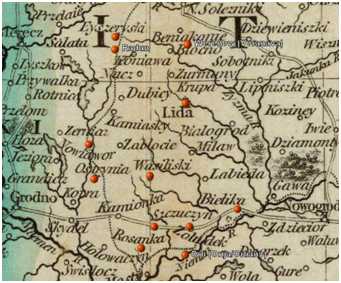 |
|
| Contents | |
| Lida Uezd Homepage | |
| Lida Uezd History | |
| Lida Uezd Towns | |
| Lida Uezd Maps |
|
| Searchable
Databases |
|
| Lida Uezd
during the Holocaust |
|
| JewishGen
Home Page |
|
| KehilaLinks
Home Page |
|
|
| compiled by
Ellen Sadove Renck from the sources at the bottom of the page
Dakudava(Belorussian
spelling), Dokudovo(Russian spelling), Dokudowo (Polish spelling)
and the dependent villages of Mikulicze, Olchowka, Pudzin, and Wasilewicze Village, center of its village government in Lida district, on the bank of the river Neman, twenty-five kilometers from Lida. 1995 population: 770 people living in 334 houses. Dokudovo was known before the second half of the fourteenth century as a Grand Principality property. In 1392, there was a war between Great Lithuanian Principality Grand Duke Votovt and Duke Korobut Algerdovich near Dokudovo. In 1436, Kuchuk owned the village. In the beginning of the sixteenth century it was owned by Kishki. Close to 1513, in accordance with the agreement of Barbara Kishchanka, the estate of Dakudovo became her husband's property. Her husband was the Governor of Grodno, Yuri Radzivil. The Catholic church was built there in 1533. In 1669, Dokudovo was mestechko (small city) in Lida povet. In seventeenth and eighteenth centuries, the Calvinist Zbor took place there. In 1763, there were thirty-seven houses. In 1795, Dokudovo belonged to the Russian Empire. In 1809, there were thirty-four houses and a church there. In the nineteenth and beginning of the twentieth centuries, the village was the volostj center in Lida povet of Vilna guberniya and was the property of Radzivil. In 1886, there were 378 people, twenty-eight houses, a church, a school, and a tavern. In the beginning of the twentieth century, 566 people lived there. In 1915 and during the World War I, the German Army occupied the territory. In 1919, the Red Army and Polish troops occupied it. In 1921, Dakudava belongs to Poland in Lida powiat of Novogrudok voevodstvo as a miasteczko (small city or town) and a wies (village) and gmina (town). The justice of the peace was in Lida and the justice court in Wilno. The post office and telegraph were in Dokudowo and the telephone in Lida or Iwje k. Lidy. The 1928 population was 654. The railway was twenty-one km. away in Niemen. Center of village government, Dokudowo had one Greek Orthodox church. Beginning 1939, Dokudowo belonged to the
Belorussian Soviet Socialist Republic. Beginning in 1940, it is the
center of a rural government union. During the World War II, 1941 to
1944, it was occupied by the German fascists [Nazis]. Sources: Sources: If
you have Lida uezd
materials to share, please considering donating it.
If you read Yiddish or Hebrew, please contact us.
Records are
held both in Grodno and Vilna archives.For Lida records translation,
your tax deductible contribution by credit card via the secure server
at either group or by mail will grow our knowledge. For a $100
donation, you receive all these records translated two years ahead of
their posting on JewishGen. Every penny collected is used for Lida uezd
projects only. Records include censuses; family lists; marriages,
births, death records; prenumeraten lists; and more. Please contact Judy Baston
with any questions.For current translations, please see the ALD:
All Lithuanian Database and Belarus
SIG Database.
|
